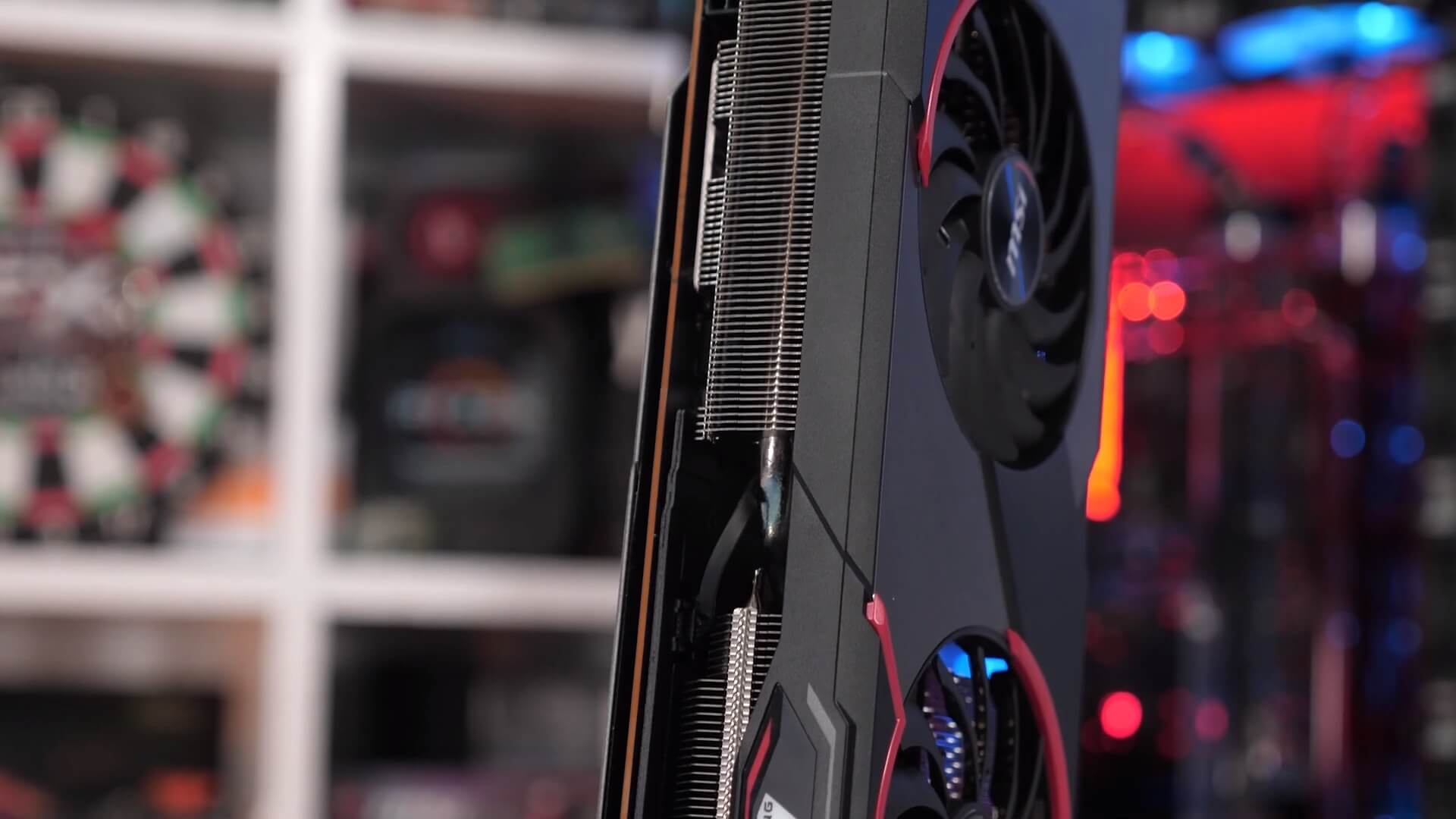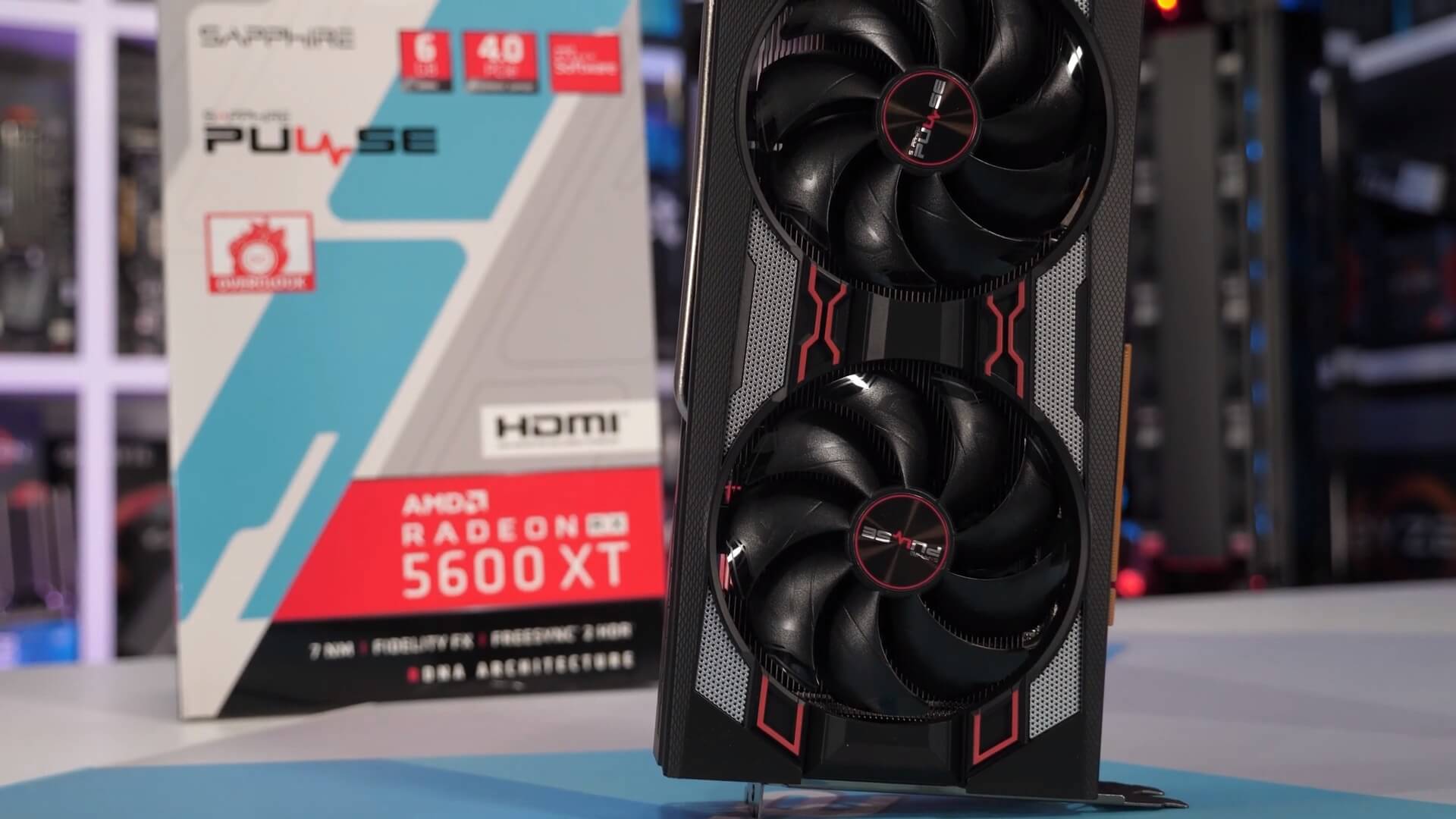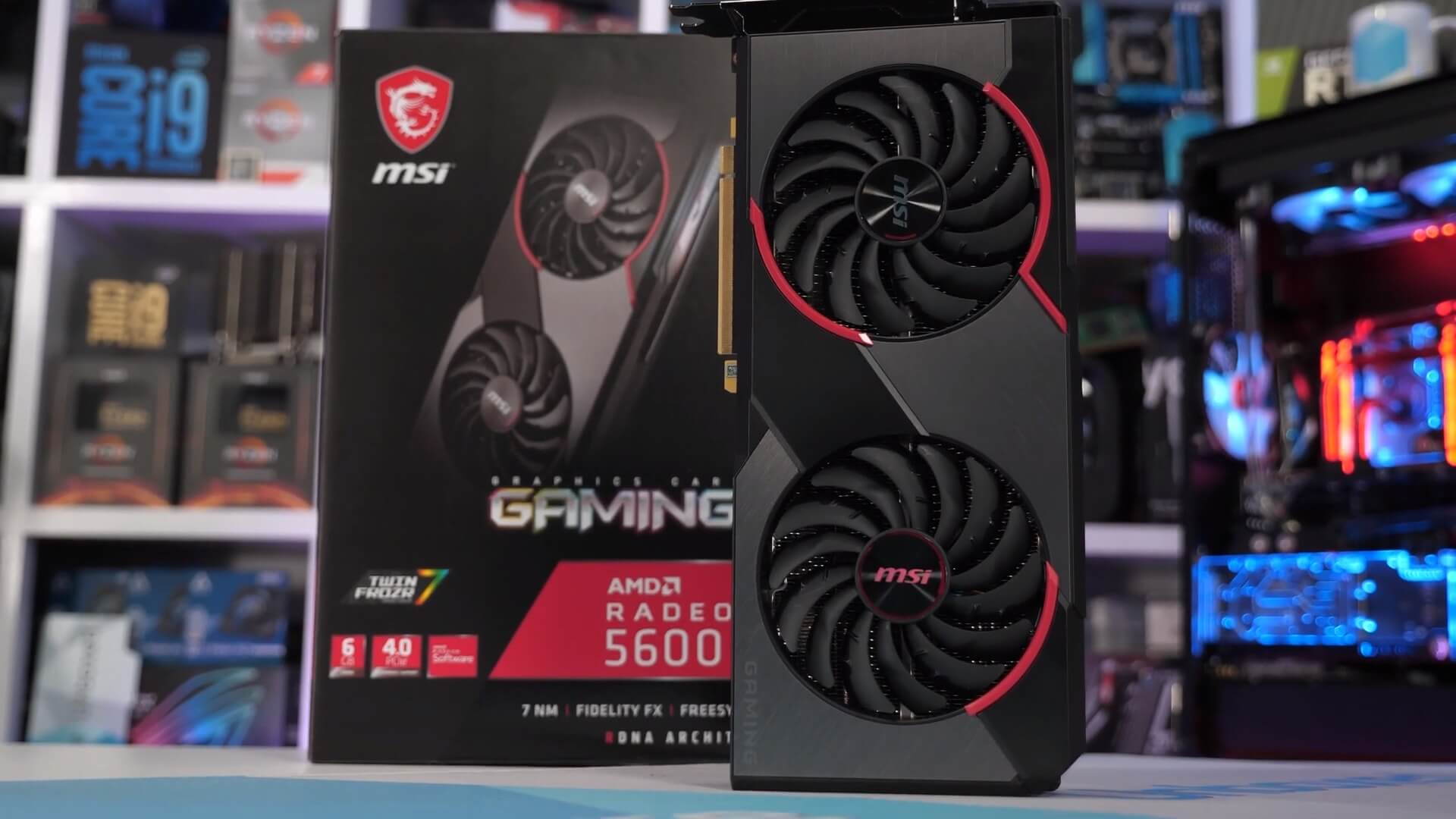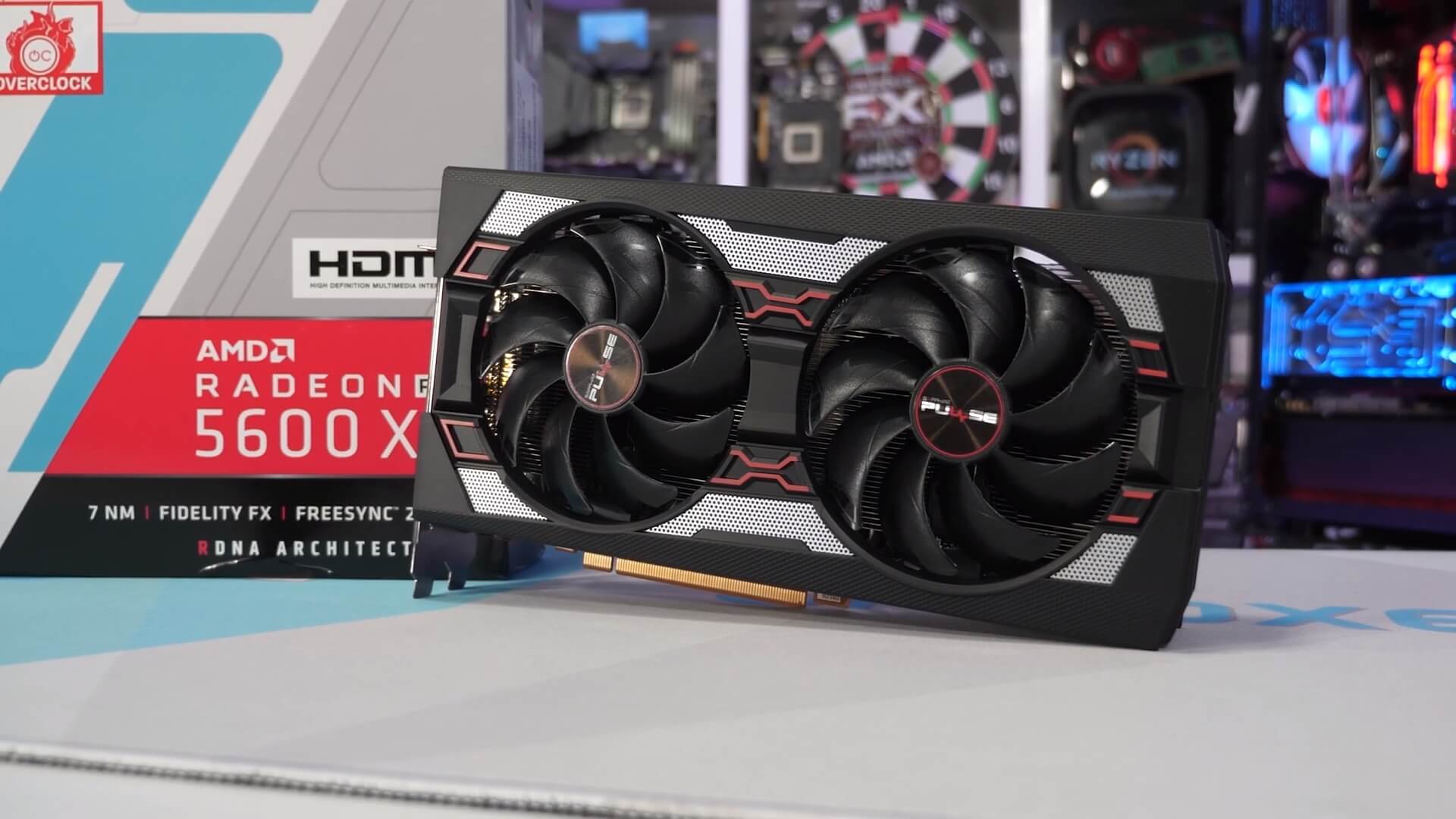Today we're test driving the Radeon RX 5600 XT for the first time since AMD unveiled it at CES 2020. As part of the announcement, we received all the important information we needed: detailed specs covering core count, operating frequency, memory configuration, pricing information and even estimated performance comparing the 5600 XT to competing Nvidia products.
That simply left us to test and confirm this information in our day-one review... until about a week ago.
In generating hype and announcing everything about the upcoming GPU, AMD essentially notified the competition and gave Nvidia two weeks notice to react and counter the 5600 XT. And that's precisely what they did. Nvidia didn't take long to drop the GeForce RTX 2060 Founders Edition down to $300, a 14% discount from the original $350 price. EVGA also announced a $300 RTX 2060 'KO' model, pretty subtle that.
We can't say if this is a limited-time only price. As of writing, both the EVGA KO and Nvidia FE models are out of stock, making the cheapest available RTX 2060 about $320. Whether or not Nvidia's price cut is just a ploy to steal AMD's thunder doesn't matter. The result is the same. AMD was forced to counter react or risk lackluster reviews at launch.
Based on the specs announced at CES, we were expecting the RTX 2060 to be about 10% faster than the 5600 XT. But with the price cut, the razor-thin price difference would have meant for the 5600 XT to be dead on arrival, and yet another bad Navi launch for AMD.
An obvious solution to this mess would be for AMD to also cut prices, but it seems this is something they're unwilling or unable to do, so the new Radeon 5600 XT will remain at $280. The less ideal and far messier option is to change the 5600 XT spec by overclocking it for better performance, and so they did.
Shortly after receiving our 5600 XT review sample, AMD sent an email saying a vBIOS update was coming to boost performance. Realizing that the 5600 XT was going to come up short, they've unofficially increased the core clock by up to 15% and the memory frequency by 17%, though rather bizarrely only increased the total power rating of the product by 7%, which doesn't add up, but more on that in a moment.
| AMD reference spec | Original Max OC spec | Updated Max OC spec | |
| Game Clock | 1375 MHz | 1460 MHz | 1615 MHz |
| Max Boost Clock | 1560 MHz | 1620 MHz | 1750 MHz |
| Memory Transfer Rate | 12 Gbps | 12 Gbps | 14 Gbps |
| Total Graphics Power | 150 watts | 150 watts | 160 watts |
We say they've increased the spec unofficially because originally AMD said the 5600 XT would operate at a game clock of 1375 MHz with a boost clock of up to 1560 MHz. Those numbers have now technically increased to 1615 MHz for the game clock and 1750 MHz for the boost, only for OC models. The 6GB of GDDR6 memory have also been overclocked from 12 Gbps to 14Gbps for the updated final spec.
This new OC ceiling intended to allow the 5600 XT to tackle the cheaper RTX 2060 models is a significant step up from the base spec. Typically we see OC models offering a ~3 to 5% performance increase when compared to the reference spec. This is what we saw with the 5700 XT range, for example. But in the case of the 5600 XT, OC models will be around 13% faster than base. And we're talking 13% faster on average, not up to 13% faster, a significant difference.
It's worth noting that AMD sampled reviewers exclusively with OC models. The Sapphire Pulse was the official board sent out to most, and we have that along with MSI's Gaming X. The problem is, there will be models such as MSI's Mech OC which will be over 10% slower than OC models and the price difference may be minimal, so you'll want to be careful with what you buy.
This change was also so late in the game that we hear the first wave of products has already shipped to retailers. That means pretty much all 5600 XT's available at launch will have the original BIOS and won't perform quite as well as what's shown in most reviews. That being the case, we'll be showing 5600 XT results both before and after the BIOS update, the before results represent the base spec.
We have a few other concerns about these changes, but for now let's look at the numbers and carry on with the discussion. For testing we're using our Core i9-9900K GPU test rig as usual, which comes clocked at 5 GHz with 16GB of DDR4-3400 memory. We used the MSI RX 5600 XT Gaming X exclusively for the 5600 XT testing in this review. We have 12 games to look at, tested at 1080p and 1440p using medium to high quality settings. Let's get into the results.
Benchmarks
First up we have Shadow of the Tomb Raider and here the updated version of the MSI 5600 XT Gaming X model is a few frames faster than the RTX 2060. You can see why the 5600 XT was overclocked further as the 11% boost seen in this title allows it to edge ahead of the RTX 2060, rather than trail it by an 8% margin.
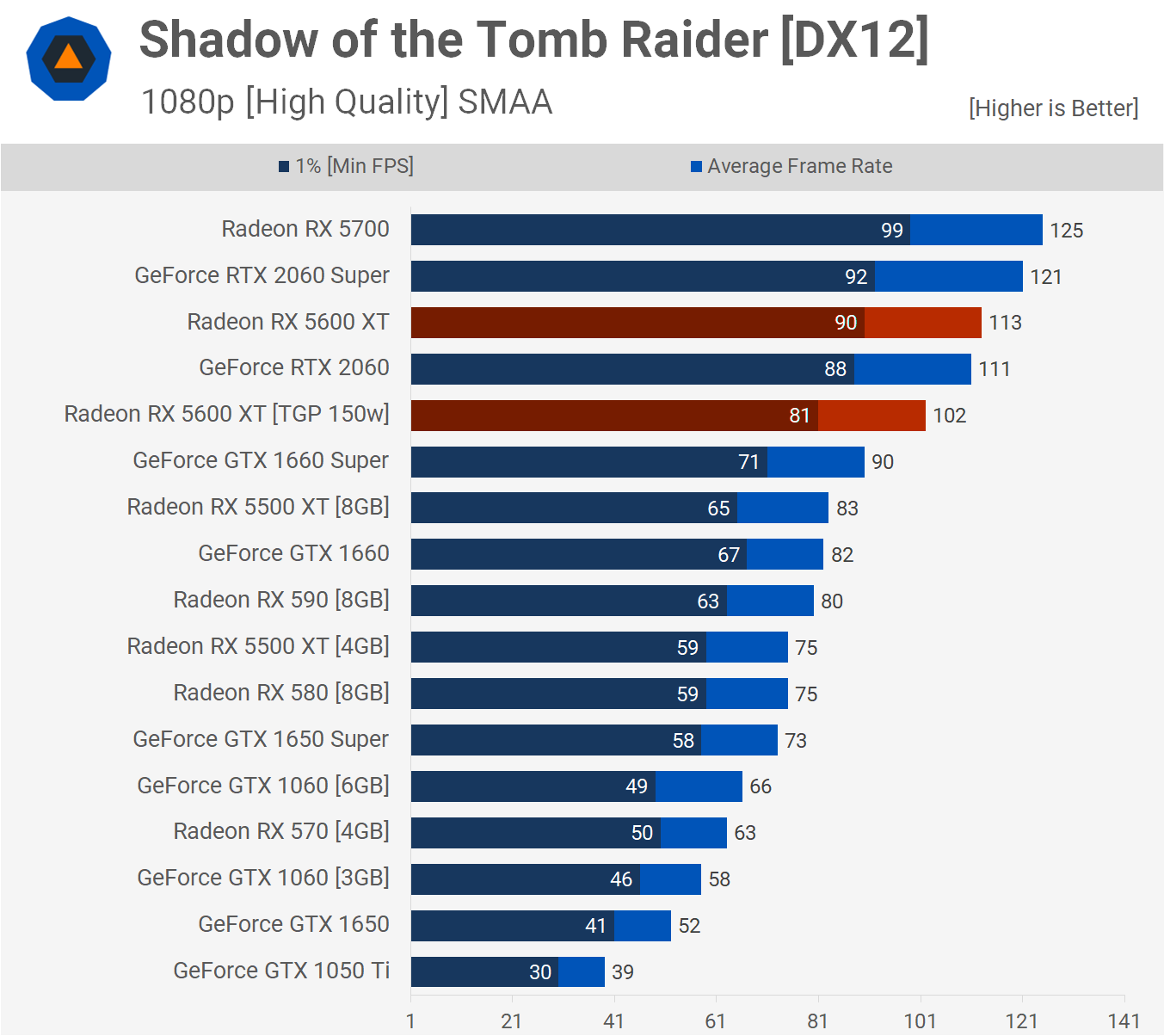
It's a similar story at 1440p, though this time the RTX 2060 manages to edge ahead of the 5600 XT by a frame, so it's a tie. Before the upgrade the 5600 XT was 12% slower than the RTX 2060.
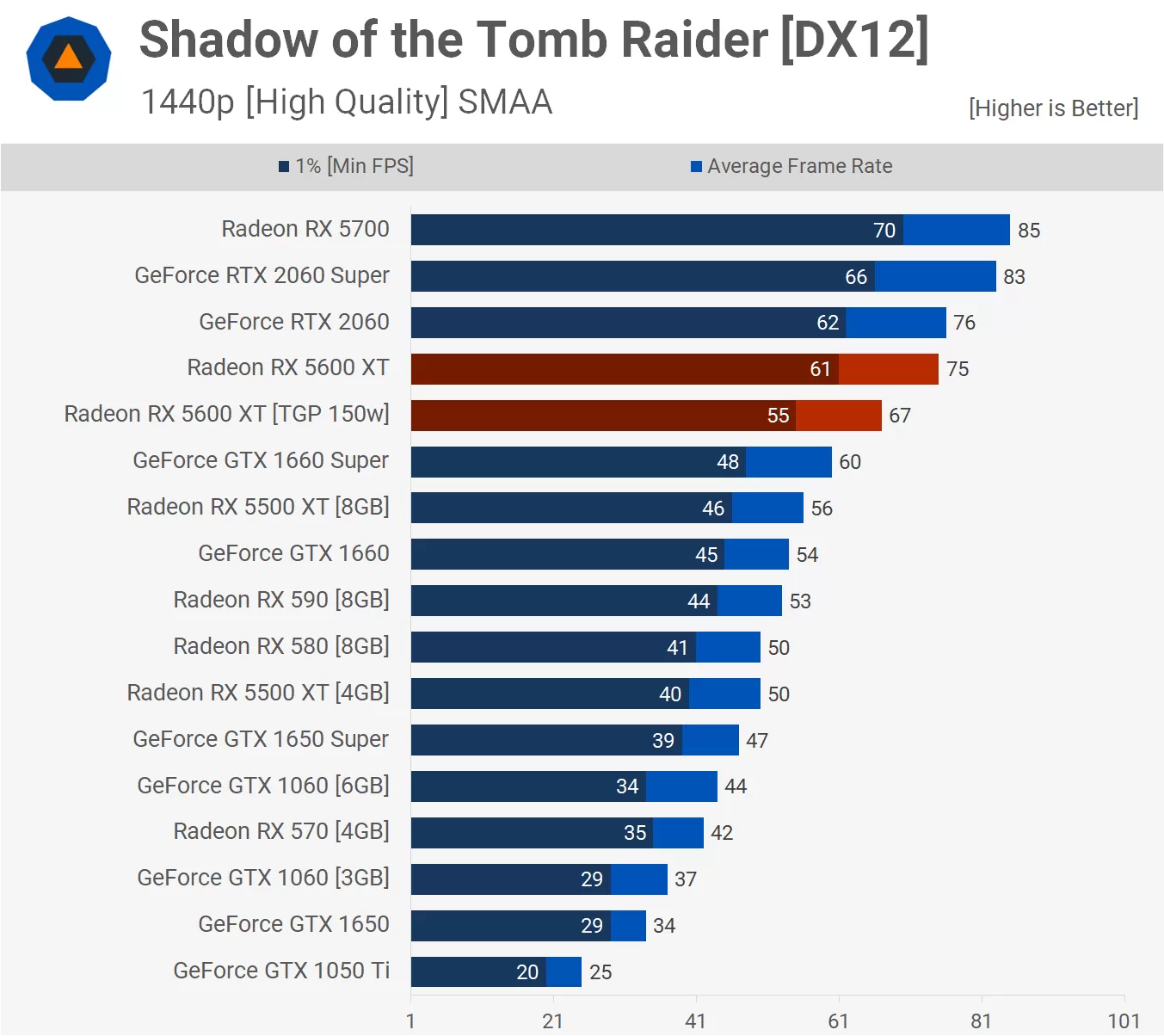
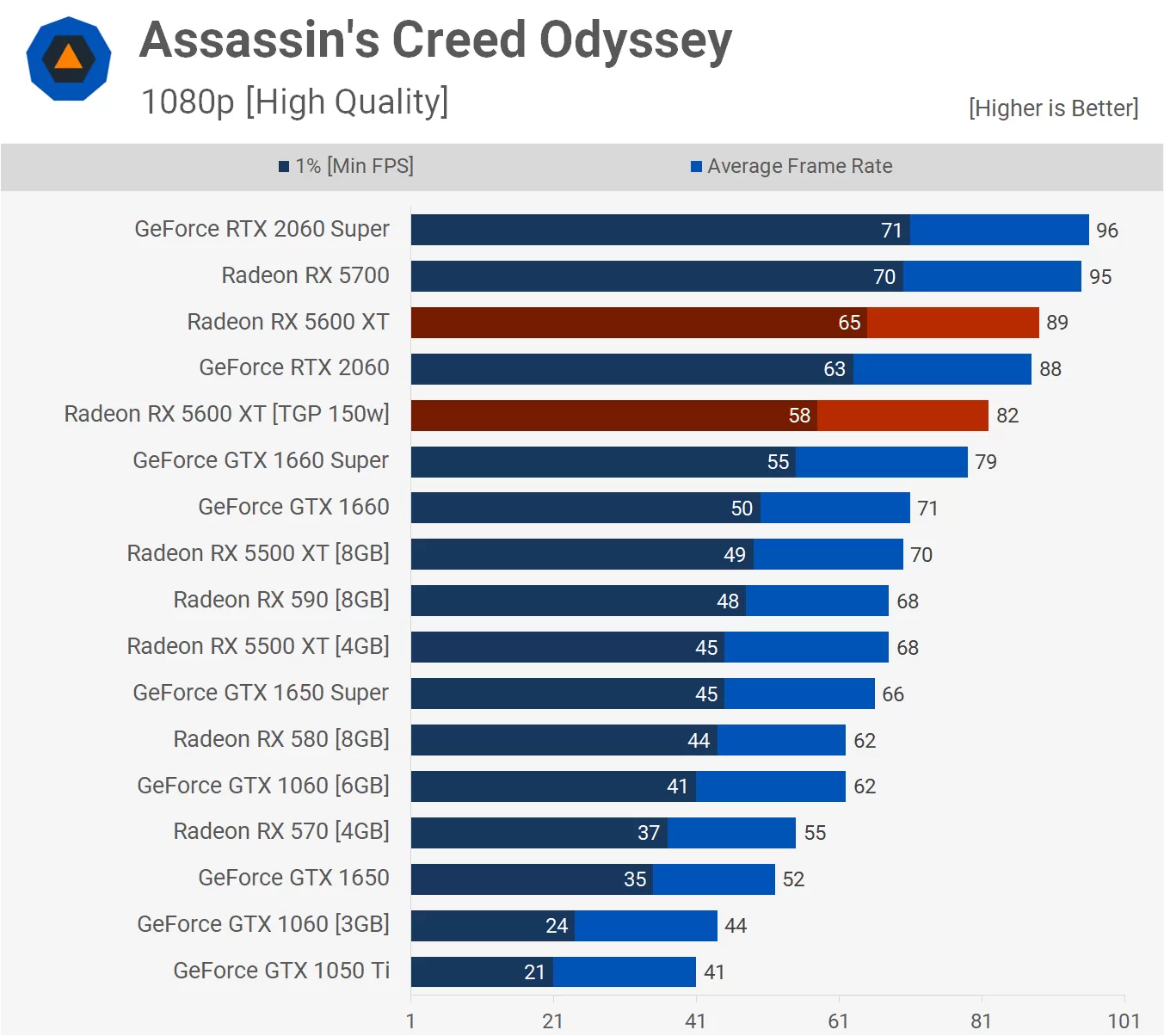
Testing with Assassin's Creed Odyssey saw the 5600 XT match the RTX 2060 after the update, and this means it's just 6% slower than the RX 5700 and 7% slower than the 2060 Super.

Identical performance between the 5600 XT and RTX 2060 is seen at 1440p and this time the new $280 Navi GPU is just 8% slower than the 5700.
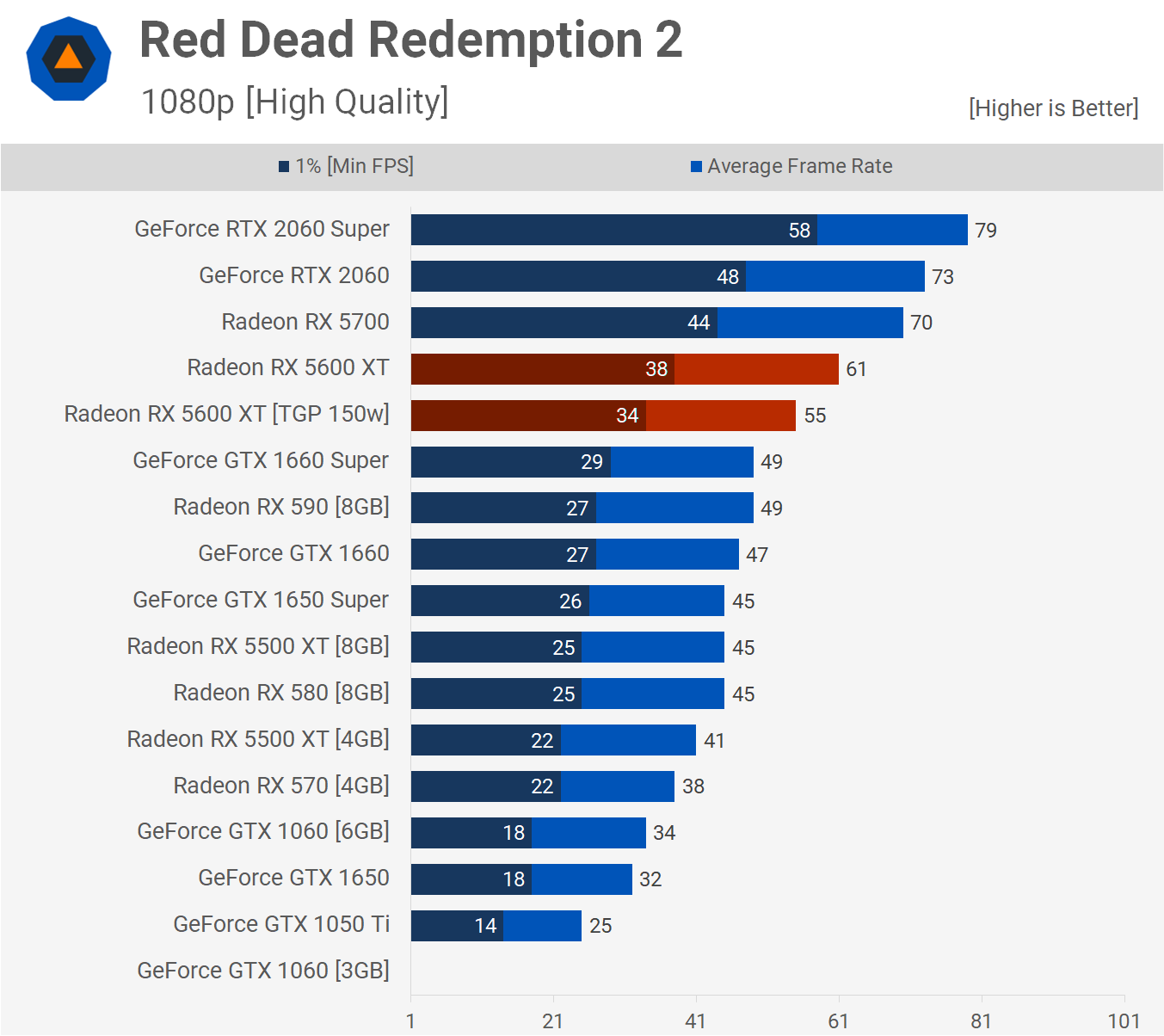
Nvidia's Turing based GPUs have become very competitive in Red Dead Redemption 2 and in fact the RTX 2060 has now edged ahead of the RX 5700.
As a result the 5600 XT is quite a bit slower, lagging behind by a 16% margin using the high quality settings with the Vulkan API.
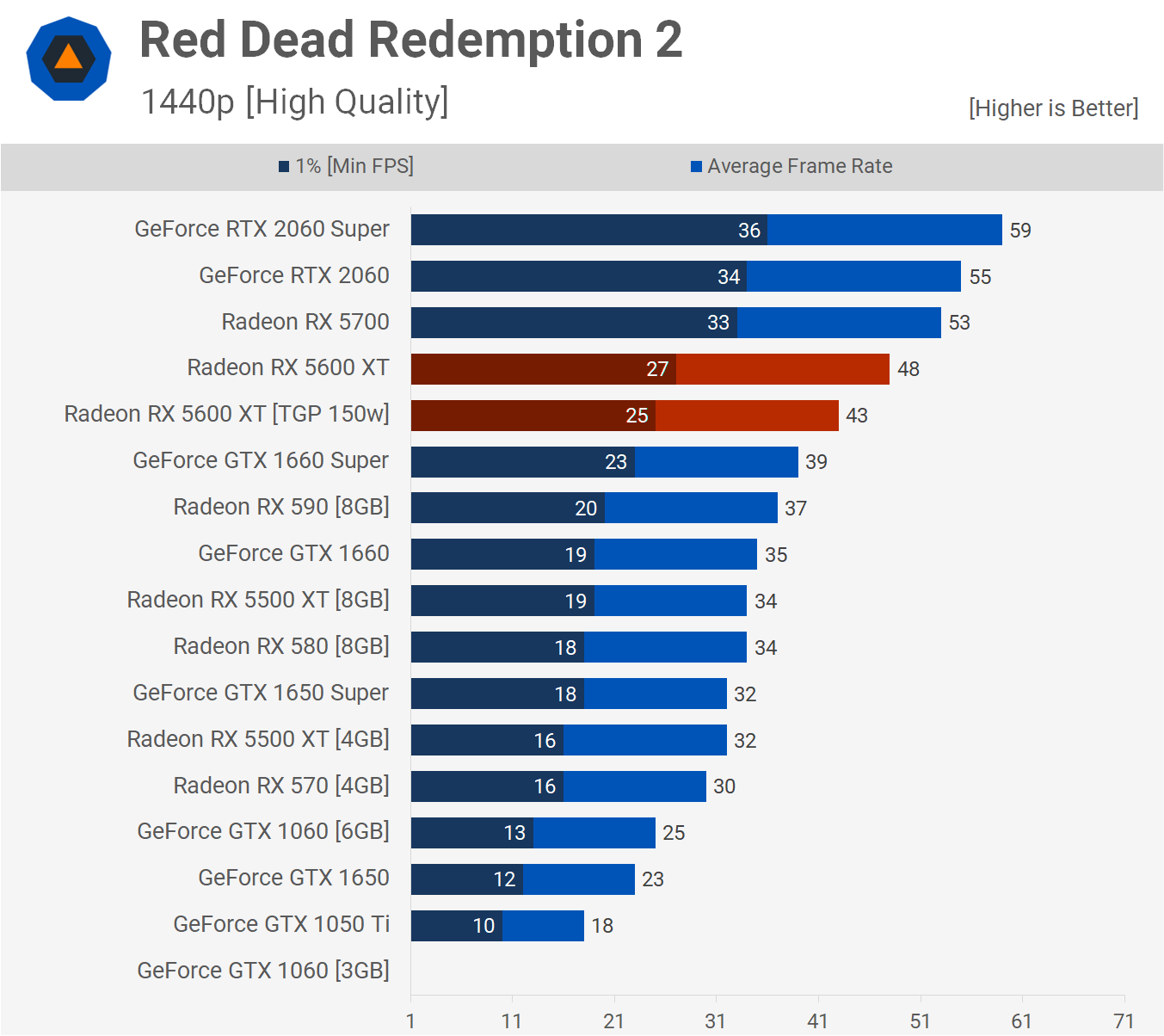
It's a similar story at 1440p as well, though this time the 5600 XT is 13% slower, still a pretty big margin though. Then when compared to the base spec the OC 5600 XT was 12% faster.

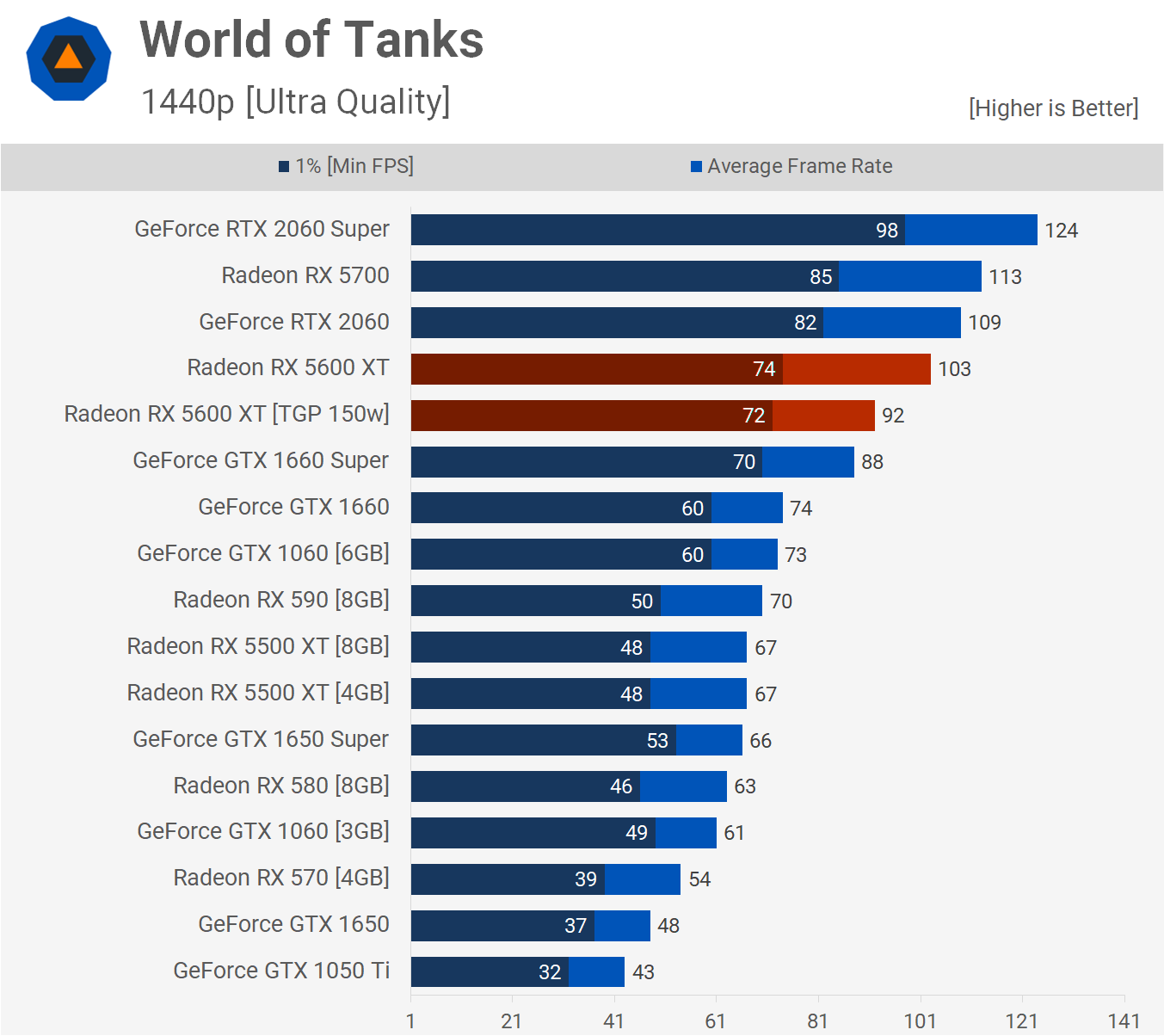
World of Tanks is another title where Turing and Nvidia GPUs in general do well. The RTX 2060 can be seen matching the RX 5700. This means the OC version of the 5600 XT was 10% slower, while the base models will be around 17% slower.
The margins close up a bit at 1440p. Here the 5600 XT OC was 6% slower than the RTX 2060, though base models will still be around 16% slower. Clearly the extra memory bandwidth is playing a key role in boosting performance of the OC version.
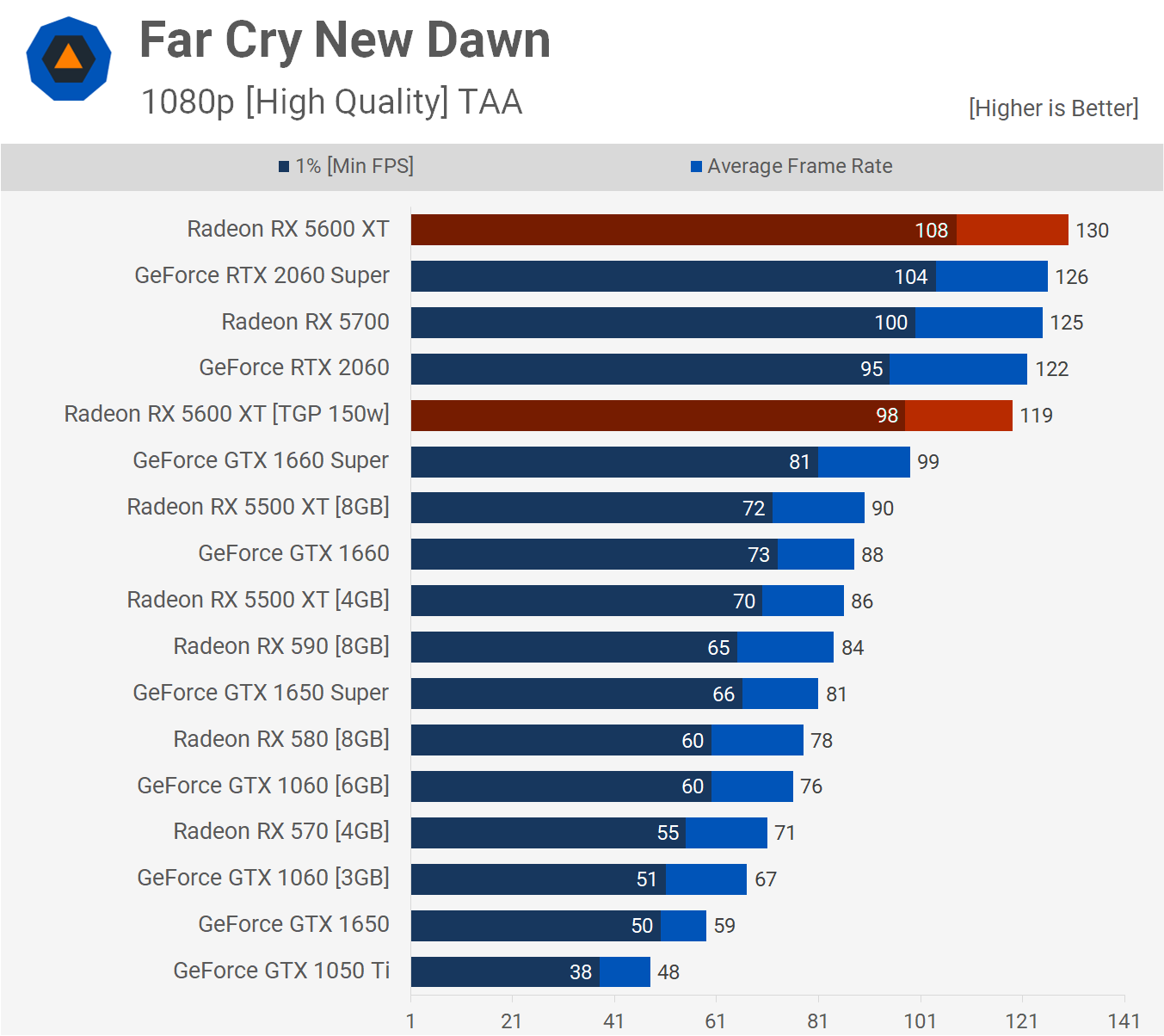
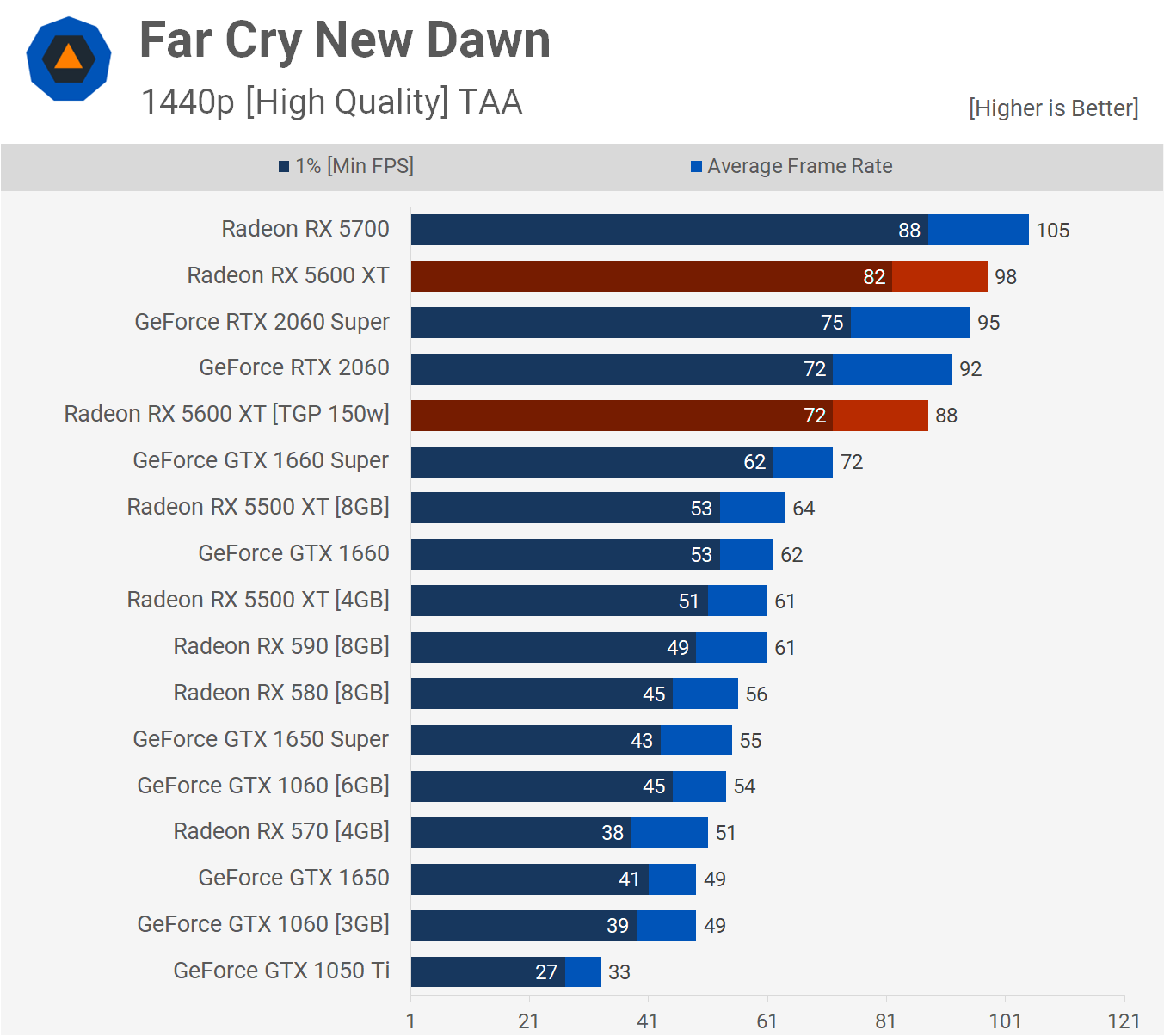
The Far Cry New Dawn results are really interesting, even at the base spec the 5600 XT is very close to not just the RTX 2060 but also the RX 5700. Even with the Core i9-9900K there is a system bottleneck.
Jumping up to 1440p does see some separation and now the factory overclocked 5600 XT is slower than RX 5700 by a 7% margin. It was also 7% faster than the RTX 2060, thought the base spec is a few frames slower.


Frame rates in Rainbow Six Siege are very competitive, here AMD's last minute OC update is enough to put the 5600 XT on par with the RTX 2060, making it just 9% slower than the RX 5700. The base model 5600 XT will tail the RTX 2060 by a 10% margin out of the box.
Interestingly, we see a situation at 1440p where AMD's 5600 XT falls behind the RTX 2060 which appears to benefit from superior memory compression technology. It's also strange to see the 5600 XT matching the RX 5700, quite a surprising result.
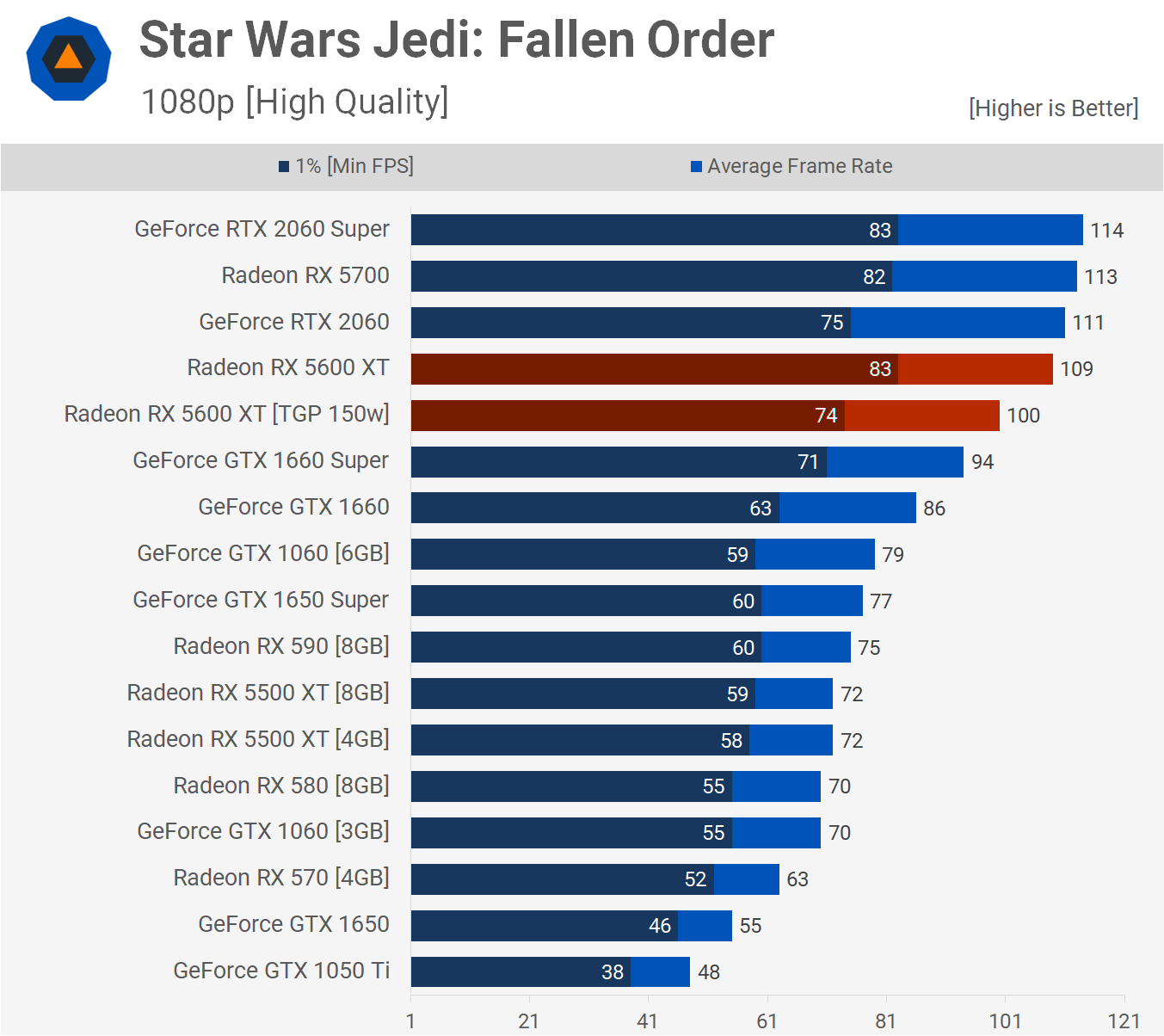
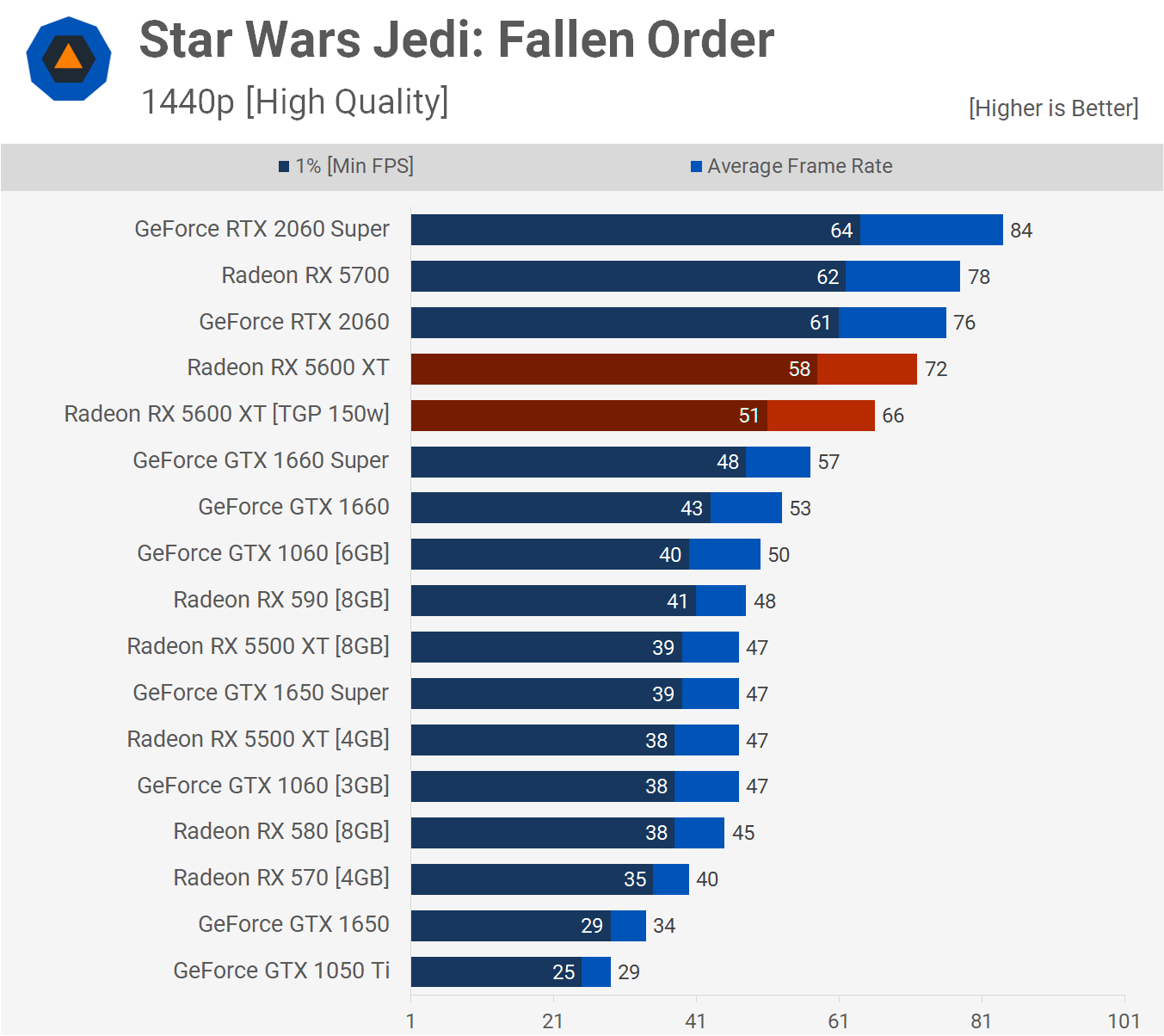
The base 5600 XT spec places it just ahead of the GTX 1660 Super which is what we know AMD was targeting originally. With the RTX 2060 price cut that wouldn't, umm cut it, so the new OC ceiling puts the 5600 XT on par with the 2060, though it also means the 5600 XT basically offers RX 5700-like performance in this title, something we imagine AMD wanted to avoid.
The 1440p resolution does give the RX 5700 a little more breathing room, but even so the factory overclocked 5600 XT was just 8% slower and 5% slower than the RTX 2060.


Next up we have Battlefield V, the base configuration sees the 5600 XT fall short of the RTX 2060 by a 5% margin, while the factory OC version was 3% faster.
It's a similar situation at 1440p, though it's interesting to note that even at this higher resolution, the factory overclocked 5600 XT is just 10% slower than the RX 5700.
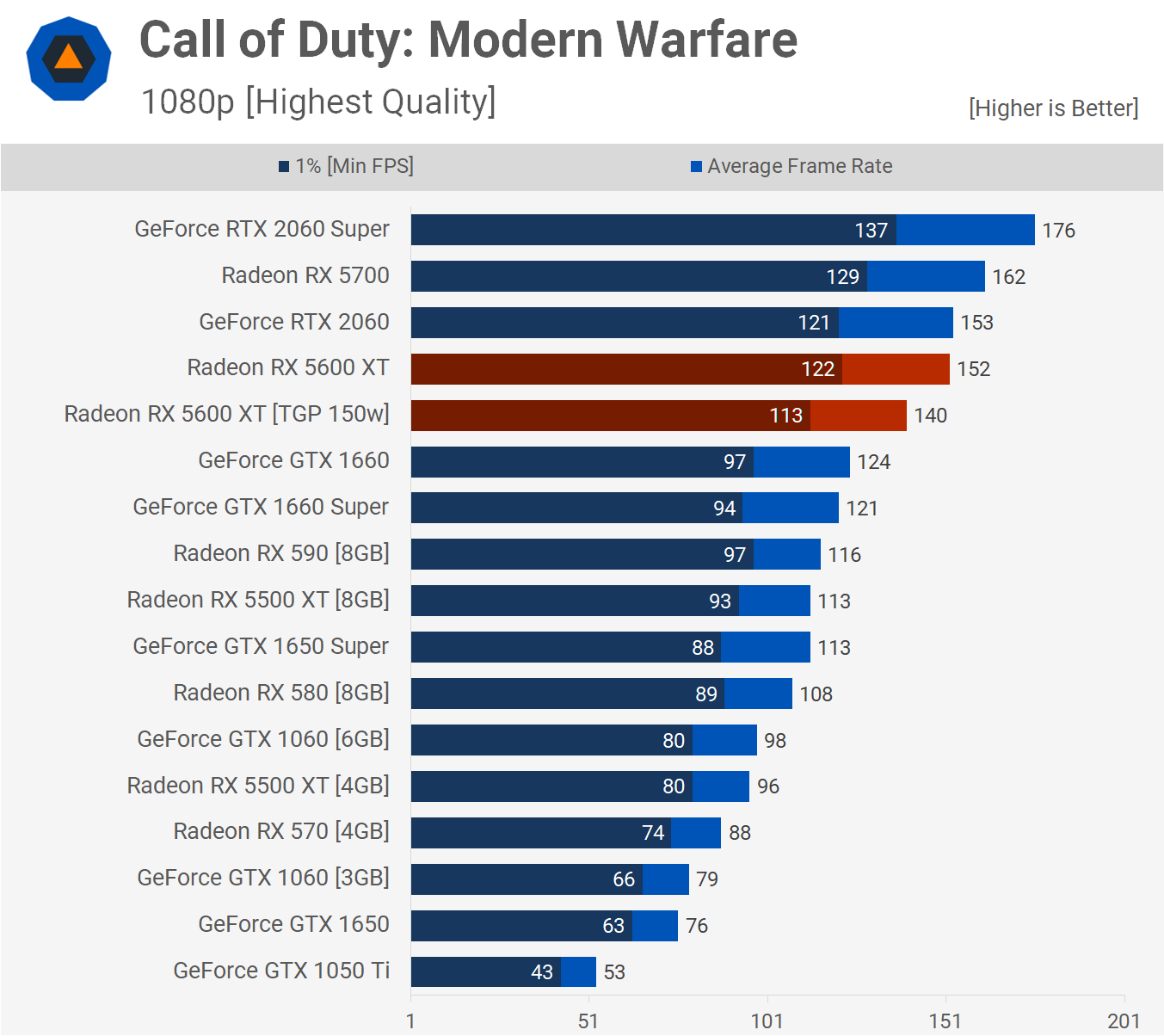
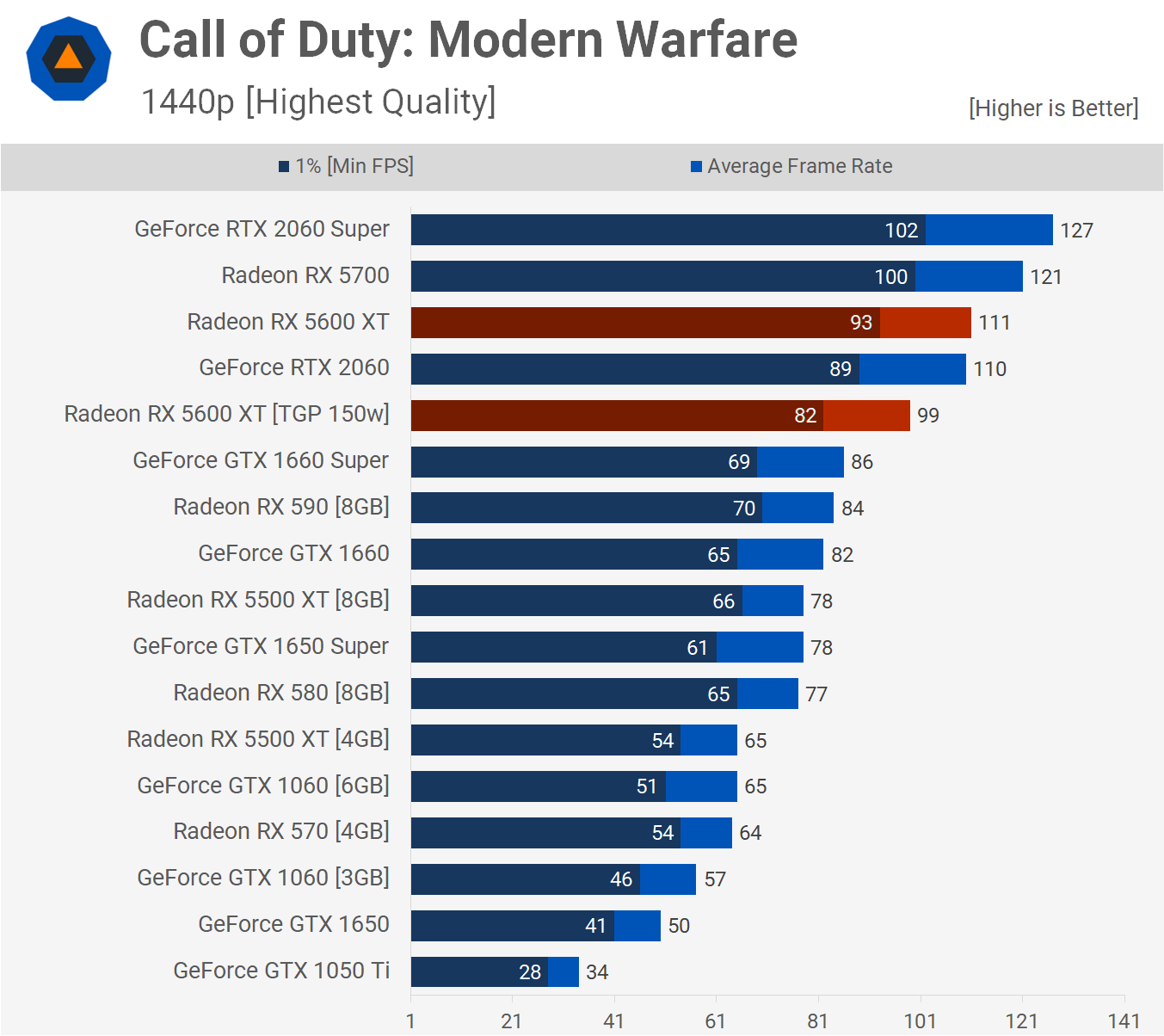
Here we see that the 5600 XT OC models will be able to match the RTX 2060 in titles such as Call of Duty: Modern Warfare whereas base models will be 8% slower.
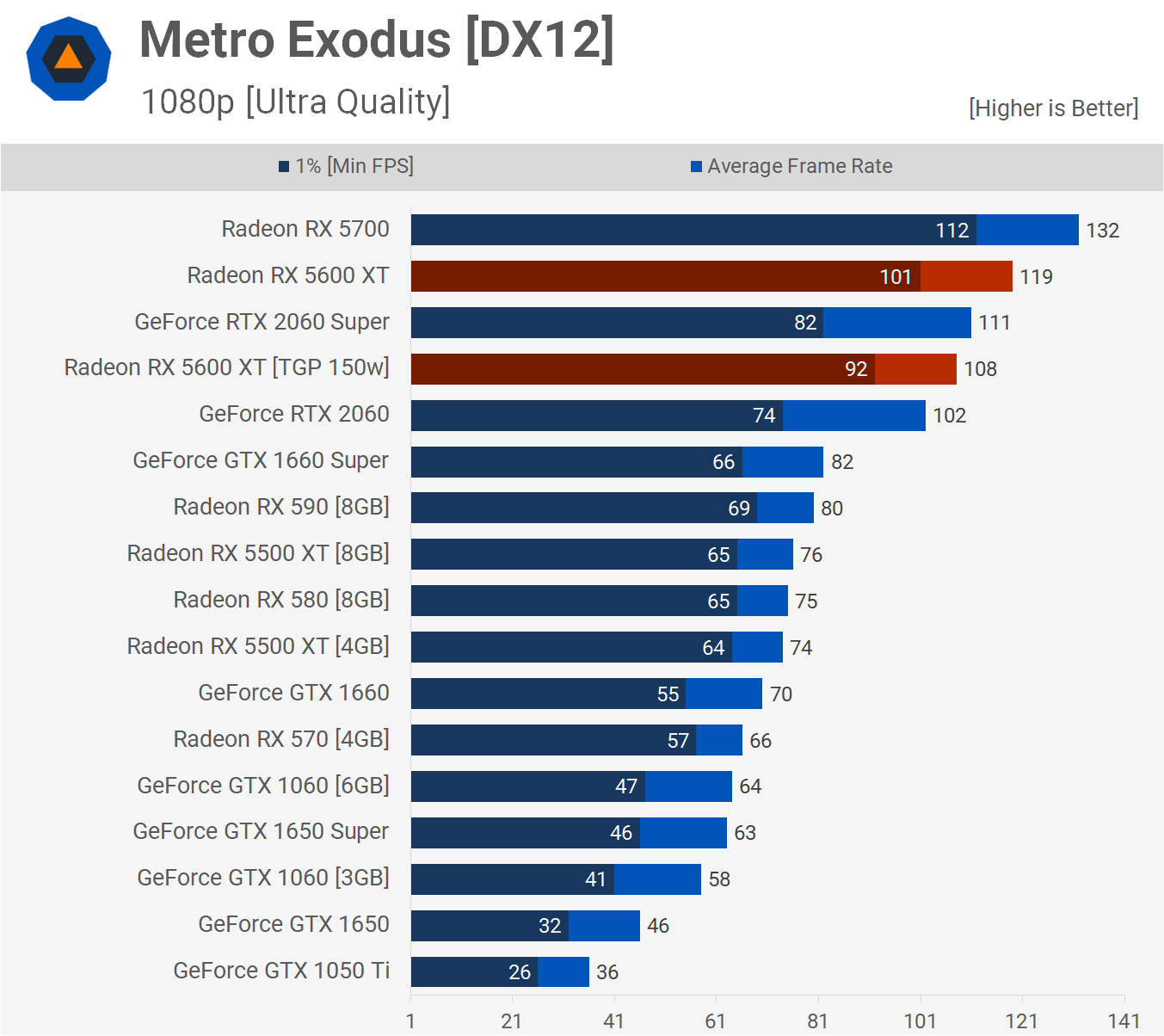
The higher end Turing GPUs seem to suffer from weaker than expected frame time performance in Metro Exodus. The RTX 2060 is quite a bit slower than the 5600 XT in that regard, even when compared to the base model. Again, the 5600 XT OC isn't a great deal slower than the RX 5700, this time it's 10% behind at 1080p.
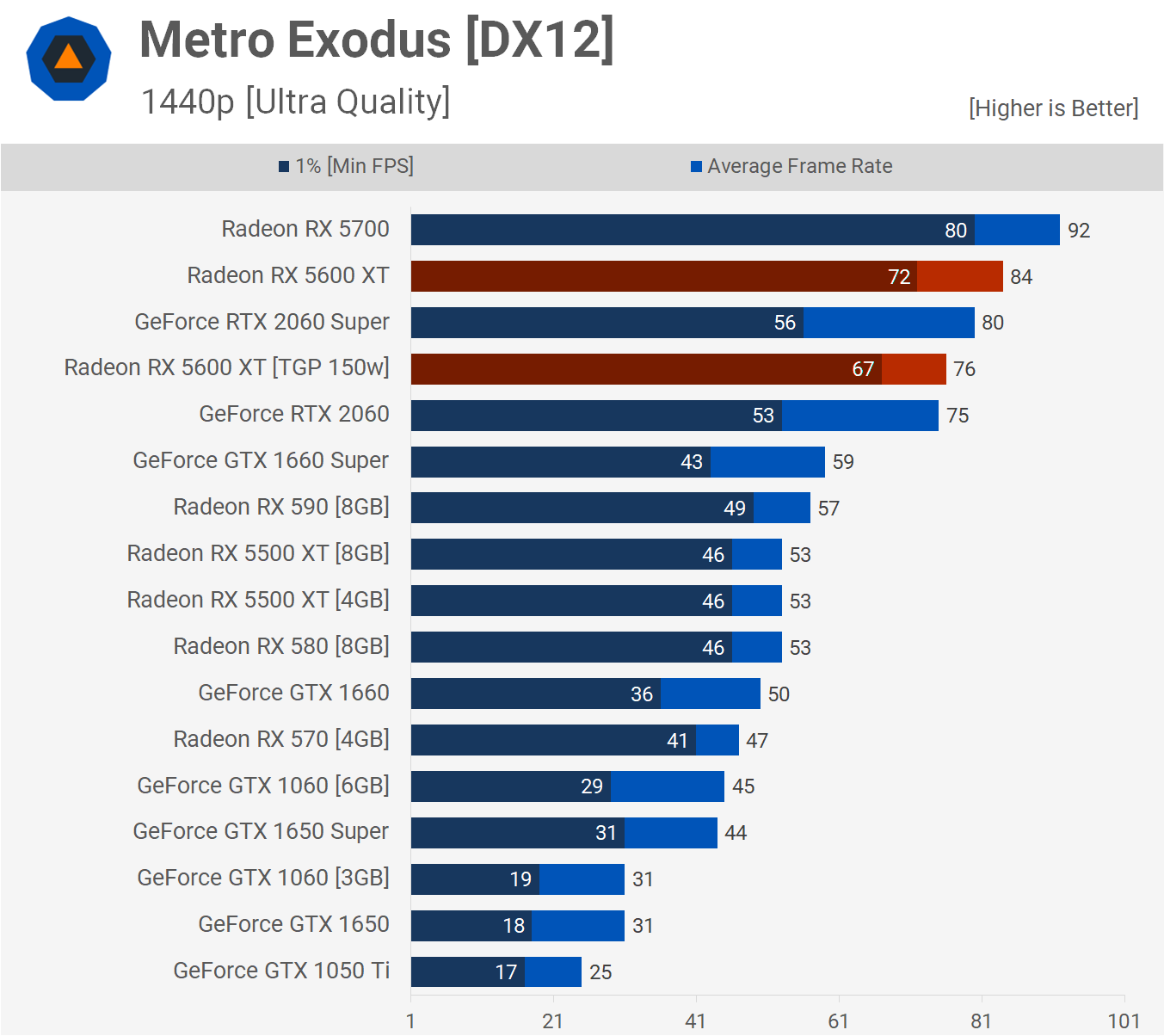
The jump up to 1440p results in similar margins. The overclocked 5600 XT is just 9% slower than the RX 5700 while it was 12% faster than the RTX 2060 when comparing the average frame rate.
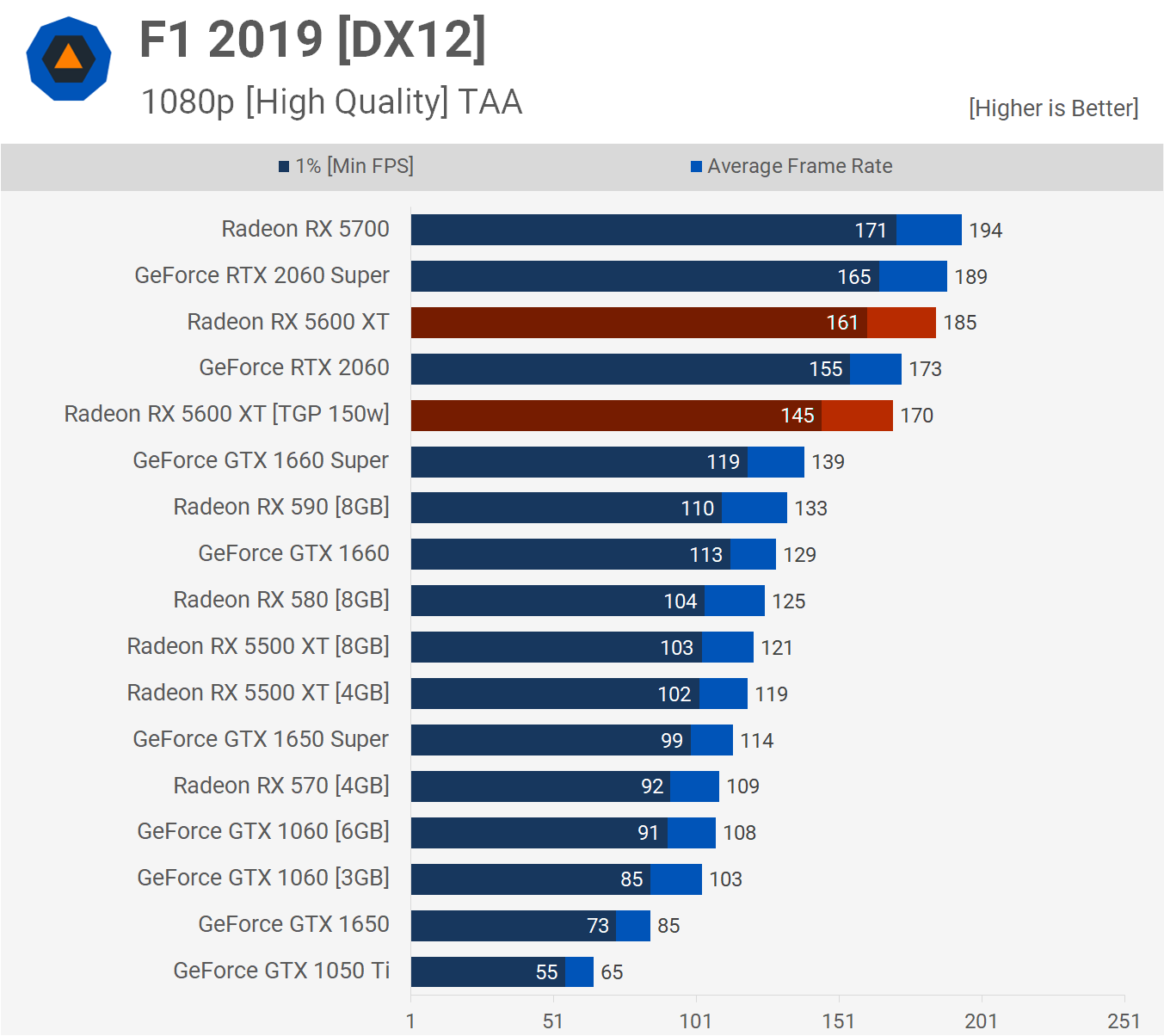
In F1 2019 the 5600 XT OC was almost at the level of the RTX 2060 Super, meaning it was 7% faster than the standard RTX 2060. We also see a 9% performance boost from the base spec to the factory OC versions of the 5600 XT.

A similar situation is seen at 1440p. It's really nice to see the 5600 XT trailing the RX 5700 by a mere 6% margin.
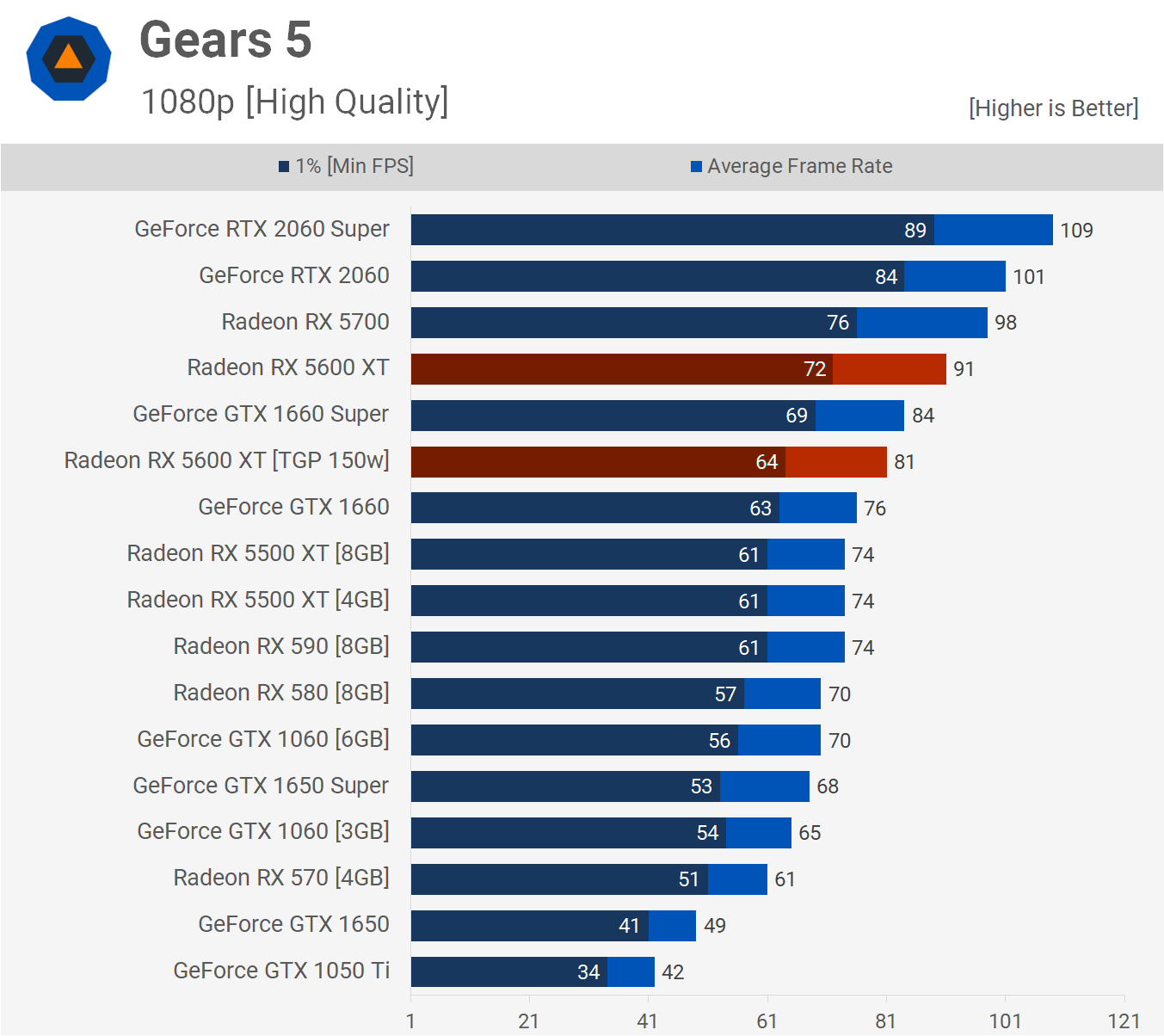
Finally we have Gears 5 and here the base spec 5600 XT averaged 81 fps while the factory OC spec was 12% faster. The RTX 2060 does well here and is just able to edge out the RX 5700, which meant it was 11% faster than the 5600 XT OC.

The 6GB 5600 XT falls away a little at 1440p as here it was 11% slower than the RX 5700 and 13% slower than the RTX 2060.
Power Consumption
Efficiency is a big advantage of these new 7nm Navi GPUs, at least when compared to previous Radeon GPUs. When compared to Turing, the factory overclocked 5600 XT is still efficient, offering a similar level of performance while saving around 20 watts total system power.

Performance Summary
You've seen how the base model and factory overclocked Radeon RX 5600 XT graphics cards perform, now it's time to see how they stack up overall and then take a look at the cost per frame data.
On average at 1080p the MSI 5600 XT Gaming X and the RTX 2060, which is also a factory OC model from MSI called the Gaming Z, they delivered the exact same performance. This also means on average, factory overclocked 5600 XT models will be around 10% faster than the base models.
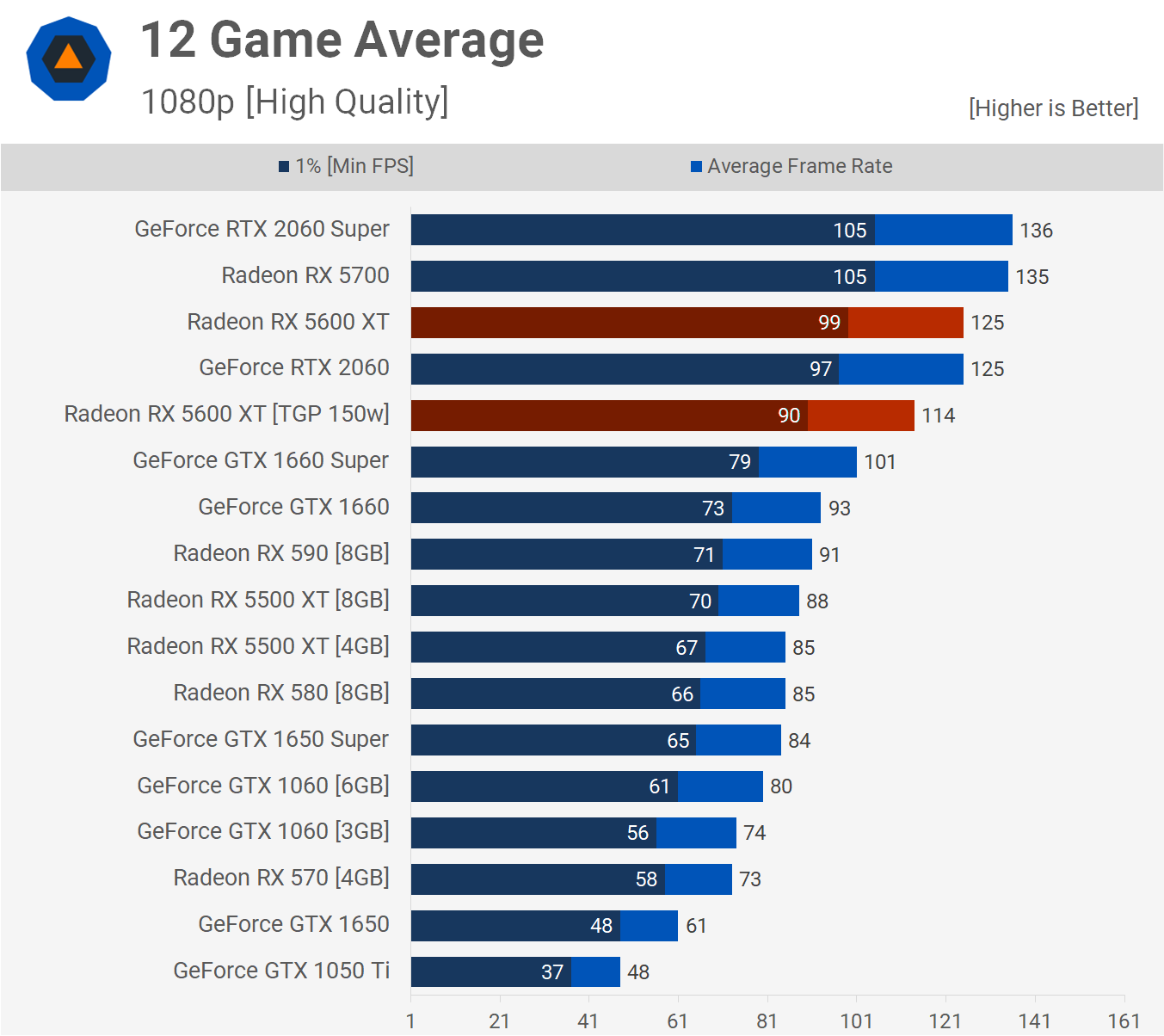
Base model 5600 XT's do have the GTX 1660 Super covered, delivering 13% more performance on average. Meanwhile the overclocked 5600 XT was just 7% slower than the RX 5700 on average and while the MSRP is 20% lower, realistically the OC models will probably be around 15% cheaper.

Even at 1440p the overclocked MSI Gaming versions of the RTX 2060 and 5600 XT are evenly matched. Base models cards will be 10% slower, but of course you can manually overclock those anyway.
Cost per Frame
This is going to get messy, but what we're trying to do here is estimate the true value of the different GPUs at their prospective price points. First, let's just compare the MSI Gaming versions of the 5600 XT and RTX 2060. Given both delivered 125 fps on average, it's pretty obvious which model wins.
We expect the 5600 XT Gaming X to be priced at least $20 over MSRP ($300), just as the RTX 2060 Gaming Z model is. We've also included two prices for the Gaming Z, the current $370 retail price, and the alleged price with the $50 discount which we've yet to see live.
Even with the $50 price cut, the RTX 2060 will still cost 7% more than the 5600 XT card. Without the price cut, the GeForce would be 32% more expensive, making the 5600 XT a vastly superior value, but we doubt price reductions won't be made effective unless some kind of shortage takes place.
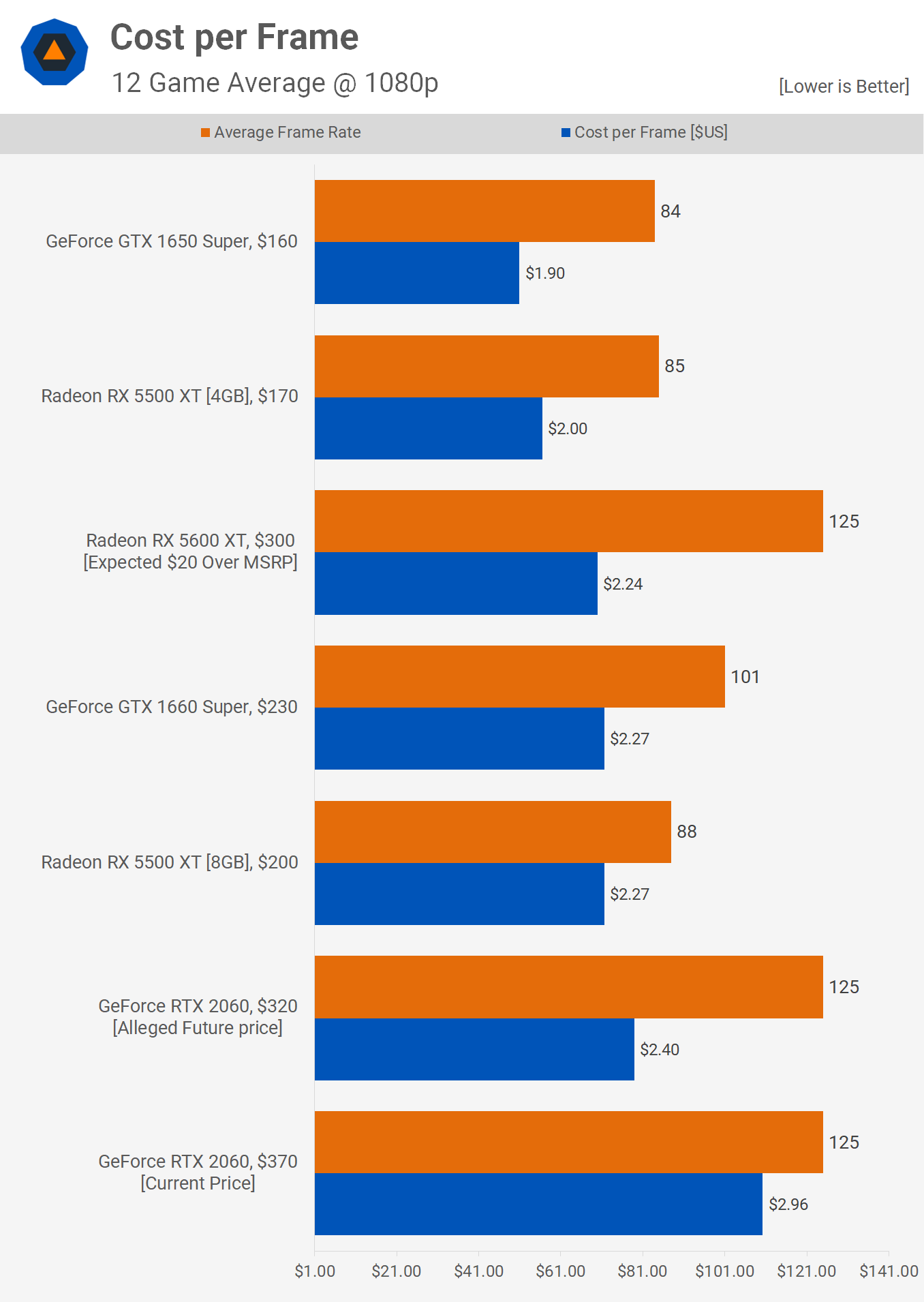
Now here's a look at cost per frame for all the currently available GPUs tested. Please note we have two RTX 2060 prices, the $330 price represents the cheapest currently available models, while the $300 price represents the EVGA KO and Nvidia FE models. Then we have two performance and price configurations for the 5600 XT: the base model at the $280 MSRP and the OC cards which we believe will come in at a $10 premium for models such as the Sapphire Pulse.

The RTX 2060 is a good value at $300, we'll just have to see them selling at that price point widely.
It's worth pointing out that the GTX 1660 Super still stacks up really well here. While base model 5600 XT's might be 13% faster, in terms of cost per frame the 1660 Super is a little better.
What to Buy?
The Radeon RX 5600 XT is a respectable product that has pushed for lower prices and better performance at $300. For that alone, we commend it. The GPU won't blow your socks off and yet it's better value than the Radeon RX 5700 and makes the RTX 2060 Super a really tough buy. Given the competition in this price range, we think AMD has done fine.
The main advantage of the more expensive RX 5700 is the extra 2GB of VRAM, which depending on the games you play, the graphics settings and resolution, may or may not factor into your buying decision. We know a lot of people will complain about the 6GB VRAM buffer, and we know where you're coming from. Ultimately, we tend to agree that 8GB VRAM should be the minimum to go for in 2020, but at least for now it doesn't matter for 1080p gamers.
About the way AMD handled this release. The last minute decision will come with some consequences in the short term. Users will have to update their vBIOS to get the most from their cards. How the updates are handled and who takes care of the process will depend on the brand, the region, and even the retailer.
Initially we were concerned by how well 5600 XT graphics cards would handle the last-minute factory overclock, but after asking around, it seems most manufacturers have simply used their RX 5700 series coolers. That should give cards plenty of headroom while letting AMD claim this is something they carefully evaluated before making the change.
We're also interested to see how many RTX 2060 cards actually hit $300 and when stock will return for the KO and FE models. We're almost expecting this to be a limited run deal to steal AMD's thunder. Worst case scenario, it forced AMD to make the 5600 XT closer to the 5700 than they would have liked.
It's no coincidence we haven't touched on overclocking, basically because the OC headroom went from hero to zero. Factory overclocked models like the Pulse and Gaming X can be pushed to 1820 MHz for the core (a 4% frequency bump), while you can squeeze 6% more frequency out of the memory. Perhaps it's possible to go a little higher using soft power play tables, but as far as convenient overclocking goes, the cards are tapped out.
Bottom line, it's good to see some more competition in the GPU space and we're the ones to benefit. AMD can probably take a note or two on how to release information and not show your hand weeks in advance. Then again, we also appreciate having pricing info more than half a day before reviews are set to go live, somewhere in the middle would be nice AMD.
Shopping Shortcuts:
- AMD Radeon RX 5600 XT on Amazon
- GeForce RTX 2060 on Amazon
- GeForce RTX 2060 Super on Amazon
- AMD Radeon RX 5700 on Amazon
- AMD Radeon RX 5700 XT on Amazon
- GeForce GTX 1660 Super on Amazon
- GeForce RTX 2070 Super on Amazon
- GeForce RTX 2080 Ti on Amazon
- AMD Ryzen 9 3900X on Amazon
- AMD Ryzen 5 3600 on Amazon
